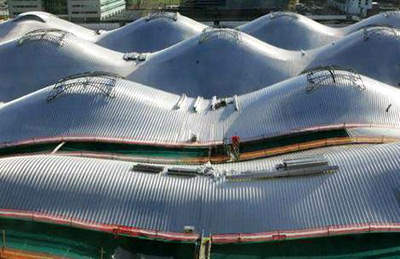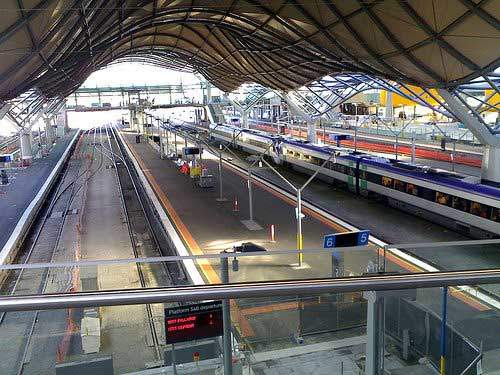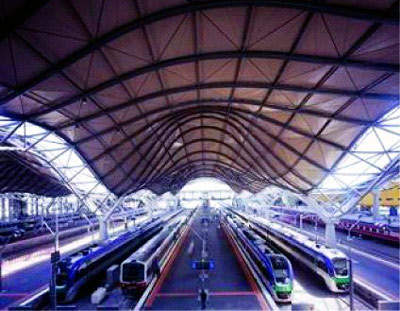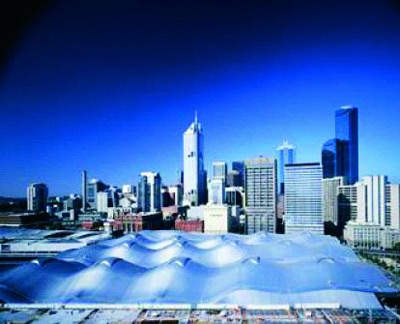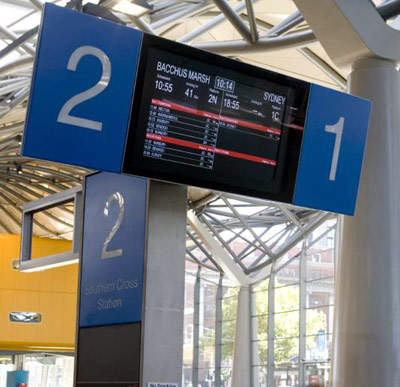Melbourne’s Southern Cross Station (formerly Spencer Street Station) redevelopment project was completed in July 2006. Just in time for the Melbourne Commonwealth Games, the station was developed into a modern well-designed airport-style facility for the city and now has state-of-the-art infrastructure.
The project, which was announced in 2000 and started in September 2002, is believed to have cost an estimated A$700m (2002 figures). As a public private partnership, the Civic Nexus consortium (the developer) was responsible for building and financing the transport interchange.
The State of Victoria pays Civic Nexus A$30m each year for the 30 years that the consortium is maintaining and operating the facility.
The station is managed and maintained by Southern Cross Station Pty Ltd.
The project has not only provided a modern station but it has also formed an impressive gateway which links the regions and the emerging Docklands precinct with the central business district of Melbourne.
SOUTHERN CROSS PROJECT COMPONENTS
The project included the redevelopment of the former Spencer Street Station into a new transport interchange and also the development of commercial areas including a new retail precinct with 800 car parking spaces and new office accommodation. The new Southern Cross has an open design light-filled space with full glass frontage to Spencer Street and Collins Street.
The redeveloped station stitches together a large part of the city providing an integrated transport interchange with essential public transport upgrades as well as pedestrian connections between Melbourne’s Central Business District (CBD) and the developing Docklands area.
The new station provides a route as well as a destination, and has created a new urban space for Melbourne. It is hoped that this increased connectivity will encourage regeneration and improve commercial growth locally.
STATION FACILITIES
Over 120 passenger information screens have been installed with real-time train arrival and departure information.
There are new comfortable air-conditioned waiting areas, a 30-bay coach terminal, new security, efficient baggage handling facilities, platform access from both the Bourke Street Bridge and Collins Street extension, secure parking for 800 cars, public facilities including toilets, internet services and telephones, new retail outlets including cafes and restaurants.
The new commercial developments include a DFO (Direct Factory Outlet) with more than 120 speciality shops and food courts.
SOUTHERN CROSS STATION DESIGN
The main aspects of the station design were practical performance, ease of passenger circulation and an improved working environment for staff. The newly refurbished interchange can now provide 15 million passengers a year, with fully sheltered, high-quality ticketing, baggage-handling, waiting and retail services, all equipped with comfortable seating, lighting and passenger information display systems.
The station interior is a vast hall with uninterrupted vistas in every direction so that the interconnection of different streets surrounding the building can be easily understood. Pods of accommodation beneath the roof house administrative functions and provide defined retail space below.
The design focus of the station is the dune-like roof that covers an entire city block: it works as a visual bridge between the city centre and the new docklands and also unites all the disparate elements of the interchange, providing a cool, shaded space on a civic scale.
The roof’s form has been generated by the requirements of the station and plays a crucial role as part of the environmental envelope. It was developed in response to the hot external climate and the internal need for diesel extraction and ambient cooling via natural ventilation.
While it is waterproof to the outside it ‘breathes’ internally, allowing smoke, diesel particles and contaminants to be discharged.
The individual roof moguls act as air reservoirs that collect hot air together with the train’s diesel fumes. The hot air and fumes are drawn through the roof, via louvres at the apex of each mogul, by the prevailing winds.
These north-west and south-west winds define the valleys that cut across the roof form, ensuring natural ventilation year round. This solution is a contemporary reinterpretation of the historic shed roofs of nineteenth century Europe. The roof intrinsically expresses its own function and its rhythmical beauty is almost incidental.
CONTRACTORS
The Civic Nexus consortium, financed and led by ABN Amro Australia, contracted Leighton Contractors, Honeywell and Delaware North Australia to work on the construction of the project.
The structural engineer was Winward Structures, the services engineer was Lincolne Scott Australia and the cost consultant was DCWC. The project started in 2002, the old Spencer Street station was closed and demolished by 2004 and the new Southern Cross station was opened in 2006.
The architect for the project was Grimshaw (working within the Grimshaw Jackson joint venture with local architect Jackson Architecture).
CONSTRUCTION
The 60,000m² (645,600ft²) project involved Leighton constructing a sweeping roof of 34,000m², which reached a height of 23m to cover the station, along with refurbishing and upgrading of rail platforms, escalators, ticket barriers and walkways. New dedicated passenger lounges were also constructed, as were baggage check-in areas and multimedia information display systems.
The state-of-the-art station design integrated a new coach and bus terminal, taxi rank and a range of other high-quality train and bus service facilities. In addition, Leighton undertook a rail infrastructure upgrade including track work, platform modifications and associated electrical infrastructure works.
SOUTHERN CROSS ROOF WATER CONSERVATION
In June 2007 it was announced that a A$1.2m project to install a storm water system for the Southern Cross Station roof would be undertaken. It is estimated that this will save up to 20 million litres of water a year.
The storm water will be used in station toilets, cleaning, and for nearby parks and gardens. The water will be collected from the roof of the station and stored in two bladder-style tanks in existing tunnels under the station. Southern Cross Station has a roof area of 34,000m², which gives this excellent potential for storm water recycling.
TRANSPORT MURAL COMES HOME
In April 2007 a 36m-long and 7m-high mural illustrating significant stages of Victoria’s transport history from 1835 to 1935 was returned to its home at Southern Cross Station.
The colourful History of Transport mural was professionally removed from the former Spencer Street Station building in 2004 to make way for development of the new world-class Southern Cross Station.
The 27 panel mural was originally commissioned by the State Government in 1973 for the main wall of the Spencer Street Station foyer; the mural took State Artist Harold Freedman (1915–1999) and his assistants five years to complete. It was unveiled in January 1978. The restored mural has been rehung at the Western end of the station.
AWARDS
The Southern Cross Station was awarded the prestigious Lubetkin Prize in 2007, one of the top architecture awards from the Royal Institute of British Architects. It is awarded for the most outstanding building outside the EU by a RIBA member and is chosen from winners of RIBA International Awards following visits by a jury of architects and a lay judge.

